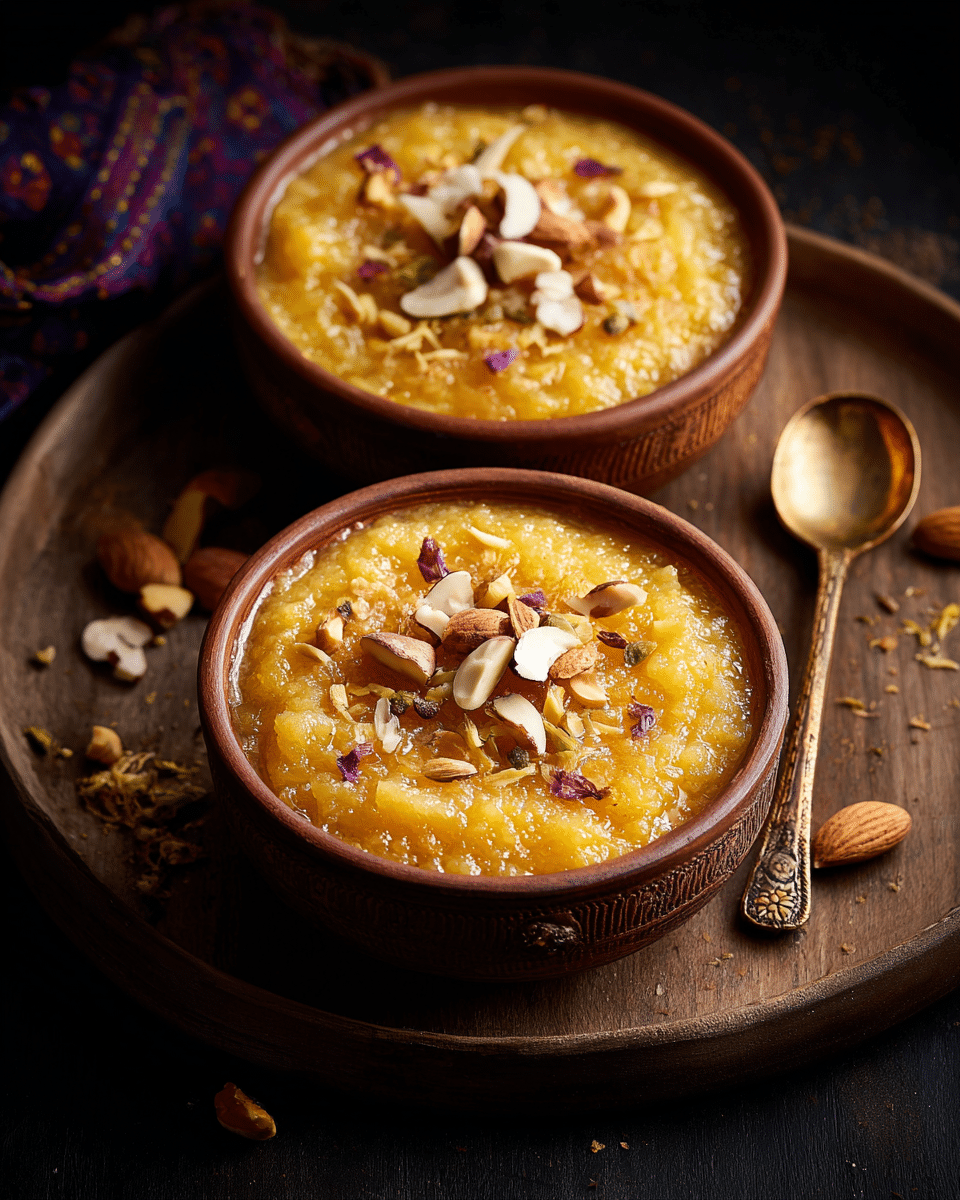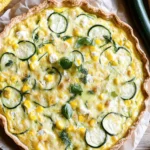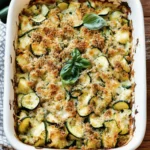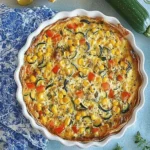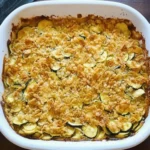Moong Dal Halwa is a luxurious North Indian dessert cherished especially during festivals like Raksha Bandhan. Made from yellow moong dal (split yellow lentils), this sweet treat is slow-cooked in pure ghee until golden brown and aromatic, then enriched with milk, sugar, and cardamom. Known for its melt-in-the-mouth texture and nutty aroma, Moong Dal Halwa is often garnished with fried nuts, making it a festive and indulgent delicacy that symbolizes love, care, and celebration.
FULL RECIPE
Ingredients
- 1 cup yellow moong dal (split yellow lentils)
- 1 cup ghee (clarified butter)
- 1 cup sugar
- 1 cup full-fat milk
- 1 cup water
- 4–5 green cardamom pods (crushed or powdered)
- 10–12 cashew nuts
- 10–12 almonds (slivered)
- 10–12 pistachios (sliced)
- A few saffron strands (optional)
Directions
- Rinse moong dal thoroughly and soak it in water for 4–5 hours or overnight.
- Drain the soaked dal and grind it into a coarse paste without adding water.
- Heat ghee in a heavy-bottomed kadhai or non-stick pan.
- Add the moong dal paste and begin to roast it on low to medium heat, stirring constantly to avoid sticking or burning.
- Roast the mixture for about 30–40 minutes, until the paste turns deep golden brown and releases a nutty aroma.
- In a separate pot, heat milk and water together until warm. Add sugar and stir to dissolve completely.
- Slowly pour the milk-sugar mixture into the roasted dal, stirring continuously to prevent lumps.
- Add crushed cardamom and saffron strands (if using), and continue to stir and cook on low flame.
- Cook until the mixture thickens and ghee starts to separate from the halwa.
- In a small pan, fry cashews, almonds, and pistachios in a bit of ghee until golden.
- Garnish the halwa with fried nuts and serve hot.
Nutrition Facts
- Calories: 450 kcal
- Protein: 8 g
- Carbohydrates: 40 g
- Sugars: 25 g
- Total Fat: 28 g
- Saturated Fat: 16 g
- Fiber: 2 g
- Cholesterol: 55 mg
- Sodium: 25 mg
- Calcium: 80 mg
- Iron: 1.5 mg
Origin and Cultural Significance
Moong Dal Halwa has deep roots in North Indian cuisine, especially in festive and celebratory contexts like Raksha Bandhan, Diwali, and weddings. It symbolizes warmth, togetherness, and the rich culinary heritage of India. Traditionally prepared with generous amounts of ghee, it represents abundance and hospitality. The dessert’s preparation involves slow roasting and patience, mirroring the care and love associated with these occasions.
Key Ingredients and Their Roles
The primary ingredient, moong dal, provides a delicate texture and a mild, nutty flavor that forms the base of the halwa. Ghee is essential not just for richness but also for the slow roasting process that develops the characteristic aroma and deep golden color. Milk adds creaminess, while sugar balances the flavors with sweetness. Aromatic spices like cardamom and saffron add a fragrant dimension, making the dish complex and festive. Nuts contribute crunch and a contrasting texture.
Health Benefits and Nutritional Value
Though rich and indulgent, moong dal halwa offers certain nutritional benefits thanks to its core ingredients. Moong dal is a good source of plant-based protein and dietary fiber, supporting digestion and muscle health. Ghee, while high in saturated fats, contains fat-soluble vitamins such as A, D, E, and K. The nuts provide essential healthy fats, vitamins, and minerals like magnesium and zinc. Moderation is key, but when consumed thoughtfully, it can fit into a balanced diet.
Variations and Regional Twists
Across India, you will find regional variations of moong dal halwa that add unique flavors or textures. Some versions replace milk with khoya (reduced milk solids) for extra creaminess, while others include grated coconut or dried fruits like raisins and dates. Certain recipes swap moong dal with other lentils such as chana dal or masoor dal, altering the taste and consistency. These variations reflect local tastes and ingredient availability.
Tips for Perfect Texture and Flavor
Achieving the perfect texture for moong dal halwa requires attention to roasting and stirring. Slow roasting the dal paste in ghee until golden brown is crucial to avoid any raw or grainy taste. Stirring constantly ensures even cooking and prevents burning. Adding warm milk gradually helps in blending the flavors smoothly, while cooking on a low flame allows the halwa to thicken evenly. Using fresh cardamom powder and good-quality ghee amplifies the aroma.
Serving Suggestions and Pairings
Moong Dal Halwa is best served warm, which enhances its creamy texture and aromatic flavors. It pairs well with light Indian breads like puris during festive meals or can be enjoyed alone as a rich dessert. Some prefer a dollop of vanilla ice cream or a sprinkle of edible silver leaf (varak) for added indulgence. Complementing it with mild beverages like masala chai or saffron-infused milk can create a perfectly balanced meal experience.
Storage and Shelf Life
Due to its ghee content and milk base, moong dal halwa is best consumed fresh or within a day or two of preparation. It can be stored in an airtight container in the refrigerator for up to 3–4 days. Before serving, gently warm the halwa on a low flame or microwave to restore its soft, luscious texture. Avoid prolonged storage at room temperature to prevent spoilage, especially in warmer climates.
Dietary Considerations and Modifications
While traditionally rich and calorie-dense, moong dal halwa can be adapted for various dietary needs. For a lighter version, reduce the amount of ghee and sugar or substitute with natural sweeteners like jaggery or honey. Using low-fat milk or plant-based milk alternatives can make it suitable for lactose-intolerant individuals. Those watching saturated fat intake should enjoy the halwa in moderation or try ghee alternatives with caution.
Moong Dal Halwa in Festive Menus
This halwa holds a prestigious place in Indian festive menus, often reserved for special occasions due to its labor-intensive preparation and rich ingredients. It is a staple during Raksha Bandhan celebrations, where sisters prepare it to celebrate the bond with their brothers. It also appears during Diwali and weddings, symbolizing prosperity and sweetness in life. Its presence elevates the entire meal with its luxurious flavor profile.
Common Mistakes to Avoid
One common error in making moong dal halwa is rushing the roasting process, which results in a raw or bitter taste. Under-roasting or not stirring frequently can cause uneven cooking and burning. Another mistake is adding cold milk or sugar too quickly, which can cause the halwa to curdle or become lumpy. Patience, continuous stirring, and gradual incorporation of ingredients are vital to success.
Conclusion
Moong Dal Halwa is more than just a dessert; it is a celebration of tradition, flavor, and craftsmanship. Its rich, velvety texture combined with aromatic spices and nuts makes it a standout dish that holds a special place in Indian festive cuisine. Whether enjoyed fresh at a family gathering or gifted during Raksha Bandhan, it embodies warmth, love, and indulgence. With careful preparation and thoughtful adaptations, this classic sweet treat continues to delight generations with its timeless appeal.

